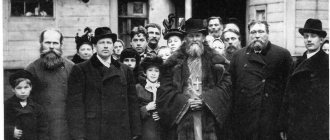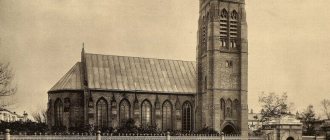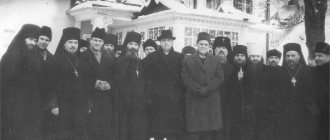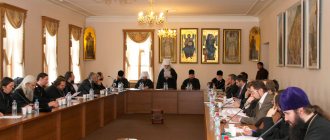Universe of Orthodoxy. Who sings in the temple?
Share
Nikolai Konstantinovich Zatsepin - Monasteries on the choir, 1852
Who sings in the temple? For Russia this is a rather strange question. Everyone understands that in our churches special choirs sing during services. Sometimes these choirs consist exclusively of men, sometimes of women. But the most common situation in our country is mixed choirs, which include both men and women.
Once upon a time, before the revolution, only men had the right to sing in Russian churches. Women were not allowed to participate in choirs on principle. In those days, women's church choirs were only available in convents. Everything changed after the revolution. The few parishioners of Orthodox churches in Russia at that time were only women or grandmothers. They eventually began to sing during the service.
In Greece there was no generation gap like ours. That is, there was no situation where, up to a certain point, the temples were full of people, and after that they were almost completely empty. The tradition of belonging to the Orthodox Church has been passed down from generation to generation in Greece. In addition, children adopted from their parents forms of participation in church life. This is not only about the fact that the sons of Greek priests often took orders themselves. But also about other, unusual for Russia, forms of service in the Church.
In Greece there are special church singers and readers who call themselves psaltis. Only men can be psaltis. Usually these are very respectable, middle-aged Greeks with extraordinary vocal qualities. For special solemnity, psaltis wear cassocks to the service - wide vestments that priests wear in everyday life. By this they show that they are part of the clergy, that is, they belong to the category of special church servants.
In the Churches of the Greek tradition, women generally have nothing to do with singing during services. Sometimes in Greek parishes there are women's or mixed choirs, but this is regarded by parishioners as an innovation and is not particularly supported.
I have a psaltis friend in Greece. This is an old man. He was once married (now he is a widower), had a secular job, but from his earliest years he sings in Church services every Sunday and holidays. The service has become an integral part of his life, so much so that he knows many texts by heart. I remember how amazed I was when I saw that this psaltis, without even looking at the book for a moment, pronounced several psalms in a row, and then sang several hymns.
The Psaltis are a real caste. You can’t just become a psaltis. Even if you have a beautiful and strong voice. Psaltis know the service very well and are well versed in liturgical books. They also have amazing hearing and therefore are fluent in the art of Byzantine singing, which is much more complex than Slavic singing. Therefore, every psaltis in a Greek parish is respected and appreciated, almost like a priest.
Priest Anthony Borisov was with you. We talked today about psaltis - special singers and readers in the Greek Church.
Contemporary singing
Currently, the church choir stands either on the sole (a raised platform near the pulpit) or on top, a special building that is located on the second floor. From above, the sound becomes better, the sound is more spacious, especially in high stone churches where the acoustics are good.
In modern churches you can most often hear partes singing and everyday life. Sometimes the works of composers are sung, although some abbots believe that such chants should only be sung in a concert hall, but not in a church.
Znamenny singing, oddly enough, can be heard more and more often in modern churches. Priests believe that such singing is stricter and more prayerful. Although it is more difficult and requires perfect pitch and good singing skills.
Antiphons can also be found in our churches. Two choir members take turns singing stichera or beatitudes, or psalms. Canonry is also common, this is how prokeemnas are now performed.
Justin Timberlake
Source: Legion-Media
Justin was born into a family where all members adhered to Baptist traditions. The singer's grandfather was a priest in the church, and his father was a conductor in a religious choir. Noticing that the child sang well, the parents decided to send him to a religious vocal group at the temple.
Timberlake, like many other world stars, began his real music career with the children's show “The Mickey Mouse Club.” It was here that he met Christina Aguilera, Ryan Gosling and future girlfriend Britney Spears. In 1995, Justin became the lead singer of the popular group 'N Sync.
How to become a church choir director
Orthodox services can last from a few minutes to 8 hours, and the main task of the regent is to be extremely focused on the actions of the clergy all this time.
Therefore, in order to become a choir leader, you need to have three very important qualities:
You will also need to go through several more important steps.
Blessing of the Priest
First of all, you need to get into the choir. This can only be done with the blessing of the parish priest or the bishop heading the diocese.
Despite the fact that any large church choir always has professional musicians on its staff, the specific nature of singing in the choir means that a secular musician cannot lead such a choir. This requires appropriate training and experience in the choir for at least 2-5 years.
Getting an education
The specialty “Church Choir Director” can be obtained after completing training in regent schools, departments or courses.
How to get to Kariye
We went there from the Kabatash pier, where our cruise ship landed.
A staircase with colorful steps rises from Kabatas to Taksim
First we took the T1 high-speed tram, for which we bought a token for 3 lira.
We got to the Topkapi stop, and then transferred to metrobus No. 34. Metrobus is a high-speed bus that travels along a special dedicated lane. You can only enter the metrobus stop through the turnstile. And again it was necessary to buy a token, but not from the seller, but from a machine.
And we only had 20 lira banknotes. There is no place to change money, the place is kind of uninhabited, there are roads and parks around.
example of Istanbul landscaping
What to do? The guy who controls passage through the turnstiles saw us rushing about, waved his hand at us and let us through, winking. They say, sometimes, pass while no one sees. This is how Turks treat tourists. And before that, at the tram stop, another controller dropped off a local guy who had the same situation. You can take the T4 light rail to the Edirnekapı stop. Continue on foot. In addition, you can take bus number 38 from the Beyazıt light rail stop and get to the Edirnekapı stop. Continue on foot. Or you can get there by bus No. 87 (route Edirnekapi - Taksim). It starts in Taksim. You need to get off, as in the previous case, at the Edirnekapı stop. We reached the Edirnekapı stop. It is located behind the wall of Theodosius, next to the Edirne gate. After passing through the Edirne gate, we found ourselves in front of a small car park. To the right stood the Mihrimah Mosque, one of Sinan's early works.
Mihrimah Mosque
The area is old and not touristic or business. In any case, we were not able to exchange euros for lira there.
The houses here are low-rise, often wooden.
However, it is home to three of Istanbul's iconic landmarks - the Wall of Theodosius, the Mihrimah Mosque by Sinan and the Chora Church. You can find the Kariye Museum by following the signs.
MAPS.ME maps downloaded to the phone also helped.
We reached Kariye in 15 minutes.
Prayer with music?
Sometimes they ask why in an Orthodox church singing at the service is not accompanied by instrumental music, as, for example, in the West, where the organ is played?
“The Orthodox church service has always been without accompaniment,” explains Evgeniy Kustovsky. — Because church singing is a coherent pronunciation of the words of prayer in time and pitch. Choristers already face many tasks to ensure that the words of liturgical texts are conveyed to parishioners. The organ, not having good instrumental diction, is rather a hindrance here.” “There are two systems of worship: Western and Eastern,” says Abbot Peter (Meshcherinov). — The Eastern one consists of prayer and teaching, which follow one after the other without pause. According to the Rules, at the All-Night Vigil there are seven places for reading sermons. Prayers and readings must be interspersed, and the only thing that is not allowed in our service is pauses. In the West, prayer alternates with reflection, that is, there is prayer, and then there is a pause, during which a person can comprehend what he has just prayed for. The organ began to fill this pause in the Lutheran service. Such a service is more aesthetically diverse than ours. But there can be no comparisons between worse and better; the service is simply organized differently. There is more space for music there. We have a more concentrated, meaningful service.” But if there are no pauses for reflection in Orthodox worship, then when should we understand the prayers and teachings read? You can try to catch as much as possible at once. You can, upon coming home, remember what was sung and read, open and re-read the Gospel, collections of liturgical hymns of the past day. Irina REDKO
print version
Tags:
Culture Temple Religious art
History of Chora Church (Kariye)
The Church of Christ the Savior in the Fields Chora in Greek , is one of the best preserved churches of the Byzantine period. The history of the church begins in the 2nd century, when the first Christian buildings existed here. Then it was far outside the city, hence the name - “in the fields”. The modern church was built in 1077-81 with the help of the mother-in-law of Emperor Alexius Komnenos, Maria Duca. Rebuilt in 1315-21 under the Palaiologos with the money of the great logothete (the highest official who supervised other officials in Byzantium) Theodore Metochites, who at the end of his life served here as a simple monk. Magnificent mosaics and paintings, which are examples of the Palaeologian revival, also date back to this time. Half a century after the capture of Constantinople by the Turks in 1453, the church was converted by them into a victory mosque - Kariye Jamia. The Turks were either too lazy to bother with the destruction of Christian images, or they felt sorry for them, and as a result they simply plastered over the mosaics and frescoes. In 1948, the Kariye Museum was opened in the temple. From 1947 to 1952, American restorers restored priceless images.
Now it is one of the most visited tourist sites in Istanbul.









